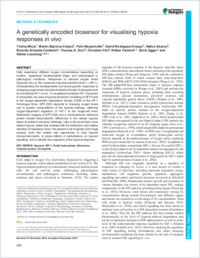A genetically encoded biosensor for visualising hypoxia responses in vivo
- Misra, Tvisha Institute of Molecular Life Sciences and Ph.D. program in Molecular Life Sciences, University of Zurich, Switzerland
- Baccino-Calace, Martin Developmental Neurobiology, IIBCE, Montevideo, Uruguay
- Meyenhofer, Felix Department of Biology, University of Fribourg, Switzerland
- Rodriguez-Crespo, David Department of Biology, University of Fribourg, Switzerland
- Akarsu, Hatice Department of Biology, University of Fribourg, Switzerland
- Armenta-Calderón, Ricardo LS Instruments AG, Fribourg, Switzerland
- Gorr, Thomas A. Institute of Veterinary Physiology, University of Zurich, Zurich CH-8057, Switzerland
- Frei, Christian Institute of Cell Biology, Swiss Federal Institute of Technology, Zurich CH-8093, Switzerland
- Cantera, Rafael Developmental Neurobiology, IIBCE, Montevideo, Uruguay - Zoology Department, Stockholm University, Stockholm, Sweden
- Egger, Boris Department of Biology, University of Fribourg, Switzerland
- Luschnig, Stefan Institute of Molecular Life Sciences and Ph.D. program in Molecular Life Sciences, University of Zurich, Switzerland - Institute of Neurobiology, University of Mü nster, Germany - Cells-in-Motion Cluster of Excellence (EXC 1003–CiM), University of Münster, Germany
-
15.02.2017
Published in:
- Biology Open. - 2017, vol. 6, no. 2, p. 296–304
English
Cells experience different oxygen concentrations depending on location, organismal developmental stage, and physiological or pathological conditions. Responses to reduced oxygen levels (hypoxia) rely on the conserved hypoxia-inducible factor 1 (HIF-1). Understanding the developmental and tissue-specific responses to changing oxygen levels has been limited by the lack of adequate tools for monitoring HIF-1 in vivo. To visualise and analyse HIF-1 dynamics in Drosophila, we used a hypoxia biosensor consisting of GFP fused to the oxygen-dependent degradation domain (ODD) of the HIF-1 homologue Sima. GFP-ODD responds to changing oxygen levels and to genetic manipulations of the hypoxia pathway, reflecting oxygen-dependent regulation of HIF-1 at the single-cell level. Ratiometric imaging of GFP-ODD and a red- fluorescent reference protein reveals tissue-specific differences in the cellular hypoxic status at ambient normoxia. Strikingly, cells in the larval brain show distinct hypoxic states that correlate with the distribution and relative densities of respiratory tubes. We present a set of genetic and image analysis tools that enable new approaches to map hypoxic microenvironments, to probe effects of perturbations on hypoxic signalling, and to identify new regulators of the hypoxia response.
- Faculty
- Faculté des sciences et de médecine
- Department
- Département de Biologie
- Language
-
- English
- Classification
- Biological sciences
- License
- License undefined
- Identifiers
-
- RERO DOC 288540
- DOI 10.1242/bio.018226
- Persistent URL
- https://folia.unifr.ch/unifr/documents/305463
Statistics
Document views: 70
File downloads:
- mey_geb.pdf: 124
